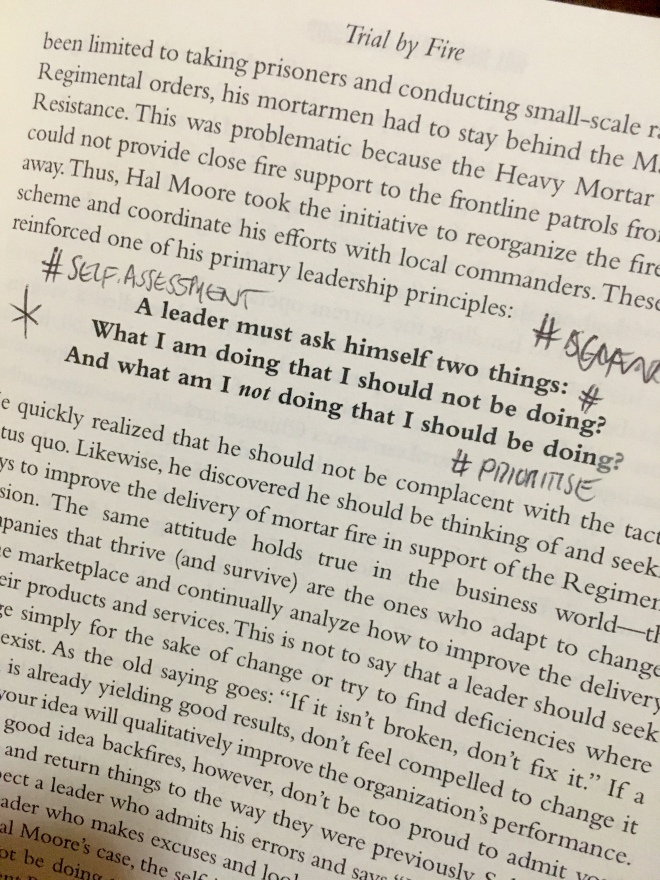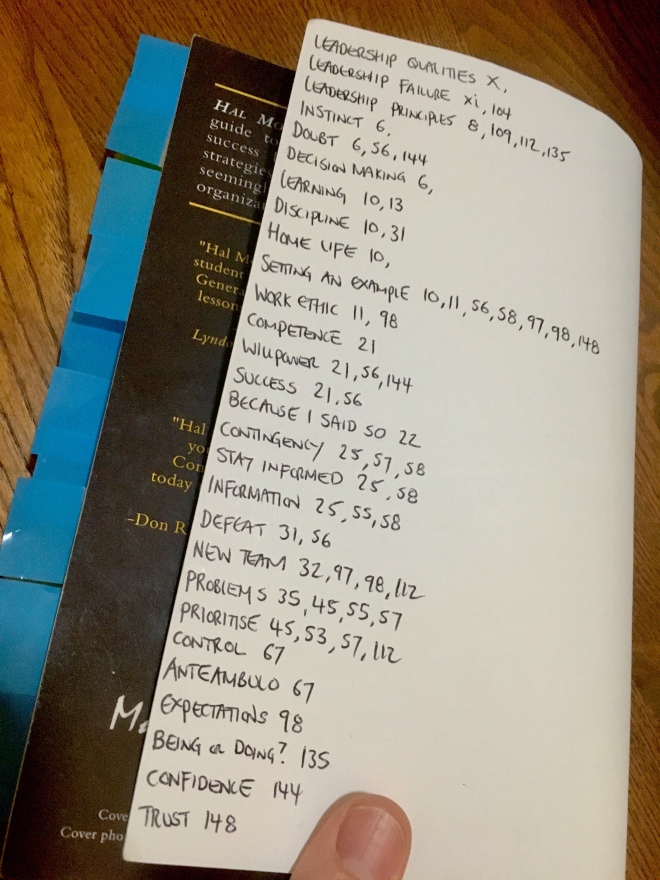First up is a book review. An easy start.
Perhaps there’s a lesson here already. “Do the easy questions in an exam first, so you get your mind warmed up”. Maybe the lesson is that “You’re destined to fail as you’ve only aimed low!” Perhaps there’s no secret author’s meaning at all and it’s just the last book I read since starting the blog.
If you’re not sure what I’m talking about, check out my previous post titled What’s it all about? for some context. When you’ve done that, come back and we’ll continue.
I first heard of Hal Moore while trail walking at the back of the Cherrybrook Rural Fire Brigade station. I’m a member of the brigade and when I can, I walk the fire trails and single track around the station, partly to better learn the trails that we may one day need to fight fires from, but mainly just for the exercise and the momentary solitude. Hal Moore was not on the trails that day. Hal Moore is in fact, quite dead. He did a lot of living though. A decorated member of the US Army, he was considered one of the countries’ finest fighting commanders and spent just over 30 years in service. No, Hal Moore was not on the trails that day.
I was listening to my favourite podcast, Jocko Podcast, by a guy named Jocko Willink. We’ll cover more on what I’ve learned from him in the coming weeks.

The sound grab that quite literally stopped me in my tracks was “If there’s doubt in your mind, there’s no doubt at all”. I rewound 30 seconds and listened again. “If there’s doubt in your mind, there’s no doubt at all”. I rewound 30 seconds and listened again. I couldn’t quite get my head around it, so I listened again – you get the picture.
It wasn’t that the hills of the Blackwattle Trail had given me an aneurysm, but when I stood there and thought about it, it’s simplicity and elegance was startling. I had to know more.
Hal Moore on leadership: Winning when you’re out gunned and out manned arrived a week later, and my journey into his thoughts on leadership began in earnest the following morning.
“If there’s doubt in your mind, there’s no doubt at all.” – Hal Moore
There’ll be no commentary on the physical book itself. It’s format, layout, size or cost, or it’s font, spelling, grammar, or the type of paper it was printed on. There won’t be that in any of the upcoming posts unless one of those things is fundamental to the learnings I took from the book. For example, I recently read (possibly an unauthorised copy, who knows?) Serve to Lead. The book is given to incoming military students at Sandhurst, with a copy neatly placed at the end of their bunk upon arrival. The spelling mistakes, the obvious transposing errors, were so distracting to the clearly remarkable content, that it created a level of concern….“What if this WAS the true copy, and thousands of graduates over its fine 71-year history were subjected to such gross and blatant malpractice? Did they notice? Did they care? Are they really the Protectors of the Realm?” There was no such concern in Moore’s book. He is unlikely to have allowed it, even from the grave.
Moore and his family, along with Mike Guardia crafted the book, which was published posthumously after his son found a half-finished manuscript while cleaning boxes out of the attic. One of the beauties of the book is that there’s no grandstanding, no holier-than-thou rhetoric – just actionable, tactical lessons from an obvious master of his craft.
The hard part came next. By the time I’d reached page 10, I’d already used 8 Post-it flags. It was a rich vein, and unlike every miner in history, I stopped digging and took stock of my approach. It had the potential to become simply bulk highlighting – I had to change my strategy. Instead of just good information, I had to determine and record the great information. It’s the first time this had happened and I wasn’t sure it would work. Would I find myself not tagging enough, or tagging things I thought I should tag instead of things I wanted to tag?

So with trepidation, I carried on. I’m glad I did.
Moore notes four foundational principles that helped him grow from a youthful, well-read, “bone-hard Kentukian“, to one of America’s most recognised wartime commanders.
- Three strikes and you’re not out
- There’s always one more thing you can do to influence any situation in your favour. And after that, there’s one more thing
- When nothing is wrong, there’s nothing wrong – except that there’s nothing wrong. That’s when a leader had to be the most alert
- Trust your instincts
Similar to many intelligent things you read, the ideas first appear simple and obvious, and you find yourself convinced that you could have written them yourself.

But you didn’t.
The beauty of seeing these ideas written down, is that it gives you the chance to digest them, to savour their simplicity. Hopefully you’ll also figure out which ones you’ll turn into takeaways that you implement in your eternal search for improvement.
Moore provides over 100 key lessons throughout the book, and a majority of them can be traced back to these foundation principles. The lessons are in bold throughout the book, so there’s little chance of not picking up what he’s putting down.

If you read the book and make it no further than Chapter 1, it’s still worth the admission price.
When you finish the book, and you will, you’ll have been rewarded with the collective wisdom of Lt. General Hal Moore, and it’s considerable.
Indexing the book was easier than I thought it would be – as his lessons are clear, concise and still relevant despite the context in which he learned them (Korea, Vietnam, and post-war USA), and really, the fundamentals of good leadership span all ages – it’s just the tools with which you have to implement them that changes.
For those who are looking for a system to help keep track of the great lessons you find in the books you read, keep an eye out for an upcoming post on Indexing.
As an aside, I’ll be providing copies of my index in every book review, and have even gone to the extent of transposing them into spreadsheet for easy filtering. The aim is to continue developing this database, so when the need arises and I find myself looking for guidance on say motivation, or leading a team, or anything in between, I’ll have ready access to the wisdom of others.
If you’re interested in having access to this spreadsheet, drop me a line or sign up to the Blog to get regular updates.

Apart from sharing my indexes, one of the things I’ll also be doing with my book reviews is providing my Top 3 Takeaways. They won’t necessarily be the headline acts from the index, but the three that I hope to turn into habits – actionable assets in a never-ending quest to improve.
Top 3 Takeaways from Hal Moore: On leadership
- Dealing with Doubt
- Dealing with new teams
- Competence
Doubt – if there’s doubt in your mind, there’s no doubt at all. It was what drew me to the book in the first place, and I’ve repeated it so many times to people since I heard it that it had to be on the list.
When you’ve got doubt in your mind about any key decision, person, or situation, then it’s a fair sign your mind is already made up. Whether you consciously access it or not, your brain, our brains, have developed a keen sense of danger over the millennia, and while the threat of lion attack is somewhat reduced in 2018, that natural instinct is still manning the sentry posts for you 24/7. Instinctual doubt reflects your personal values and awareness – so remember that what might signal caution to you may not even register with someone else. Always remember to consider things from as many perspectives as time permits when making any kind of assessment or decision.
This awareness of doubt has made a surprisingly immediate impact on my life. Those 70/30 calls are no longer as tough to make. 50/50 ones are always going to be hard, as it’s doubt either way that’s likely created the decision point anyway. The simple quote that drew me to Moore in the first place is now soundly locked in the vault of a change in habit.
Dealing with new teams. Moore relished the thought of developing teams. He didn’t see it as a personal merit badge to show he could turn the fortunes of these groups, but more that he truly believed every team had the potential to be great. Moore believed that through solid leadership, a winning attitude, and often just sheer doggedness, any team could succeed.
So what exactly is my takeaway? It’s that regardless of the performance, or perceived performance of a team you’re new to leading – there’s always the opportunity to improve. Setting expectations early, setting standards high, working tirelessly in the interests of the team and the mission ahead of yourself, and simply believing that you can, and will succeed, regardless of your objective. Easy right?
With leading new teams, I missed the opportunity recently to really leverage off this. My new team is great, and unlike Moore I had no need to whip them into shape. Could I have introduced a new or different dynamic when I arrived? Sure. Have I done this without an explicit set of operating guidelines to the team? Only they’ll be able to tell you that. What I have taken from Moore though is that when teams are in distress, or lack specific guidance, that providing a clear set of guidelines, expectations, and standards of performance are critical. To turn a ship like that, this guidance needs not only to be explicit, but you have to then live it yourself. It’s called uncompromising leadership. It’s also likely to be a tough conversation to have, and one you may need to have often, but it’s better to be prepared for that with a combat veteran by your side.
“If given a choice between taking over a good outfit or a bad outfit, I’ll choose the bad outfit every time. They’ll have nowhere to go but up” – Hal Moore
Competence. Moore was a firm believer that high levels of competence are critical to the success of a team. Again, seems obvious right? Moore took it next level, and if there wasn’t a trained operator behind the trigger of the heavy machine gun, or a recognised pilot at the control of the chopper, then the squad wouldn’t leave the security of the wire. Initially this bristled the establishment, but his insistence of trained, competent personnel in his squads saw all his teams, and ultimately the Army (as part of his future roles), better trained, better motivated, better prepared, and more confident.
“Without competence, willingness is meaningless” – Hal Moore
I often comment that having a team member that’s keen and willing is 80% of the battle in a hot market, and I’d certainly prefer a less skilled but willing Manager or Engineer in my team over a skilled but disinterested one. But surely what we really want in our teams, are willing AND skilled personnel. On the outset it seems easy enough….Generate energy and willingness in your team. “Check“. Provide your team with the training. “Check“. Struggle (but get through it) while they’re away on the training. “Hang on, Check“. Struggle when they leave because they’re now more highly skilled. “Hey?!, Check“. Struggle for an eternity as your team stagnates or leaves anyway because you’re not invested in their development. Check mate.
My takeaway? Train. Train. Train your team. Then provide the leadership and environment that makes them want to stay.
“Train people well enough so they can leave, treat them well enough so they don’t want to.” – Sir Richard Branson
Three simple takeaways that I’m committed to introducing into my leadership habits. Let’s see where they take us…..
Overall I can’t recommend this book highly enough. For those of you who burr at the thought of another military-based leadership book, allay your fears – specific combat references are sparing. For those of you who are looking for guidance from a specialist leader, searching for simple, actionable tips on leading yourself and teams, then Hal Moore: On leadership. Winning when out gunned and out manned is a must for your library.
As Hal would say, “Drive on!”
Have you read the book and wanted to share your thoughts?
Have you got any comments or thoughts on my Top 3 Takeaways?
Have you spotted a spelling mistake and just can’t stop yourself from bringing to my attention?
Let me know!
Leave a comment below, or sign up to the Blog for more Leadership lessons from the everyday.


I enjoyed your article Michael, very informative. I like the idea of indexing too and would value access to it. Me, I’m currently reading Turn the Ship Around!
LikeLike
Steve – glad to hear you enjoyed the article. I’ll send through a copy of the Master Index ASAP.
Turn the Ship Around – that’s the David Marquet one isn’t it? Would love your thoughts on it when you’re done!
LikeLike
I forgot to add, no spelling mistakes identified……
LikeLiked by 1 person